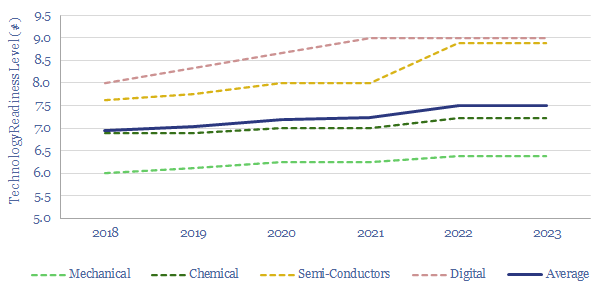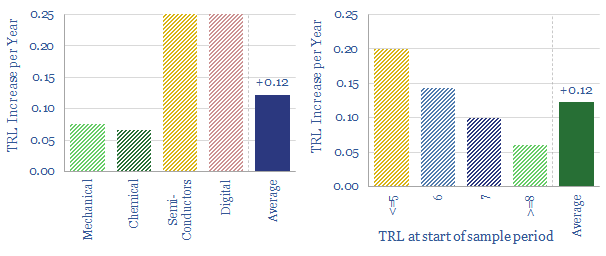This 12-page note looks back over 5-years of energy technology development. Progress has often been slower than we expected. Maturing early-stage technology takes 20-30 years. Progress slows as work shifts from the lab to the real world. We wonder whether 2050 will look more like 2023 than many expect, with more value for incumbents; or if decarbonization goals must rely more on today’s mature technologies?
This note looks back at 25 technologies, which we have written about and tracked since 2018. What has surprised us, maybe even depressed us, is how slowly many have progressed.
Energy technologies considered in the note include blue hydrogen, SiC power MOSFETs, hydrogen vehicles, TOPCon solar, remote working, plastic pyrolysis, post-combustion CCS, battery recycling, supercapacitors, aerial vehicles, Allam Cycle Oxy-Combustion, BECCS, direct air capture, airborne wind, metal organic frameworks, drones, molten carbonate fuel cells, deep geothermal, autonomous vehicles, chemical looping combustion, AI-supported concentrated solar, direct lithium extraction and nuclear fusion.
The average technology in our screen has only gained 0.12 rungs of the TRL ladder per year, especially mechanical-chemical technologies, at 0.07 rungs/year (chart below).

Semiconductor and digital technologies are an exception and have tended to progress around 3x faster than mechanical or chemical technologies; which augurs well for solar, EVs, electrification and digital technologies in the energy transition.
We wonder whether the media/markets are overly optimistic on energy technology development? Or whether investors are fairly compensated for technology risk? For example, if we look at companies that have folded in the last five years, we can often find scores of earlier media articles trumpeting them as “the next big breakthrough” or a “game changer for energy transition”.
More soberly, it may be a route to disappointment, maybe even financial distress, to assume a 5-7 year technology development cycle on an early-stage chemical-mechanical technology, encountering challenging real-world variability, and needing to construct large stick-built production facilities? Our analysis suggests these technologies more likely take 20-30 years to progress from early-stage technology to fully de-risked status.
More optimistically, this conclusion underlines the importance of considering energy economics, economic modelling and reviewing patents, in order to identify genuinely exciting technologies, which can overcome the inevitable roadblocks. There really are “technology breakthroughs” and “energy transition game-changers” out there.
Overall is there more persistent value in incumbents and in technically ready decarbonization solutions, such as natural gas, LNG and nature-based solutions?
Page 12 of the report is a five-point framework, which we have based on our findings in the report and our experiences over the past five years, to help decision makers de-risk the route to maturity for emerging technologies. We hope this is useful, and will be using this framework when assessing new energy technologies in our future research.
